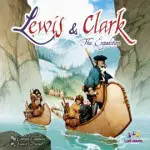It doesn’t really matter whether I like a game or not. What matters is whether you will like it. First, you have to learn the game. So, here’s my judgment-free exploration of Asmodée’s Lewis & Clark: The Expedition…
(Explored by Drew Davidson)
Lewis & Clark: The Expedition
Asmodée Editions – asmodee.com
Designer: Cédrick Chaboussit
Players 1-5
Playing Time 120 min.
Analysis Paralysis Factor: 8/10
Learning Curve: Hard
Best Table Size: 3 chairs
Weight: Heavy
Footprint: Large
Type: Historical Hybrid
In 1803, President Jefferson called Meriwether Lewis & William Clark into the Oval Office and tasked them with exploring the breadth of his recent Louisiana Purchase. But what if he had told them that only the first of them to reach the Pacific Ocean would win glory? You’d have Lewis versus Clark.
That’s the premise of Lewis & Clark, an engaging racing game that combines hand management with worker placement.
Set-up
Each player starts the game with 3 resources, 1 native token and 6 unique 2-sided character cards. One side shows the character’s action, while the other side shows the character’s strength when assisting others in their actions. Thus, you are constantly forced to choose which side of a character’s card to use.
Among the starting 6 are a leader, tasked with moving the expedition upstream; an interpreter, whose skill is in recruiting natives; and four resource gatherers, who collect Wood, Fur, Food or Equipment. Every character displays a resource icon on both sides of his card. The icons on already active cards will determine how many resources are gathered during an action.
Actions
To perform an action, you play a card face up then activate it by playing on it either the reverse side of another card (showing a strength from 1-3) or 1-3 native tokens. This signifies the number of times you can repeat that action.
After your action, you’ll have the opportunity to recruit one of 54 historical characters to your expedition. They’re made available 5 at a time for a price, with the powerful cards costing more resources.
Game board
Taking up the greater part of the board is a Village where only natives can perform actions. Usually only one native can be played on each action. Among the actions are (1) gathering resources, (2) converting them into boats, or more valuable resources; (3) copy a card that has already been activated by another player.
Only after an Interpreter is played are all the Village spaces cleared and available again. While natives that were used to activate character cards return to your expedition when you camp, those played in the Village stay there until recruited again.
On the river
While resources are unlimited, there are a limited number of boat tiles to purchase. The tiles have two sides; a smaller boat comes with 2 resources, and a larger boat that can carry 5.
Whenever you have played all (or most) of your characters and natives, and used up most of your resources, it’s time to camp. Camping locks in the advances your scout has made, but it also forces you to assess the state of your expedition. Unused cards and a surplus of resources and natives will bloat your expedition and force you back downstream before you can actually set up camp. Then you’re allowed to take up the cards you’ve played and start fresh.
The home stretch
In the second half of the journey, the river changes twice from smooth water, where movement requires one type of resource, to mountainous white water, where movement requires another. This prevents players from focusing on just one type. These 4 changes in terrain help keep players from getting too far ahead or too far behind.
An unusual rule for a Euro game: your token (called a Scout) can’t occupy the same space as another, so when you end your turn in another player’s space, your Scout jumps to the next unoccupied space. There can be quite a bonus if you time your movement correctly.
The winner is not the first to reach Ft. Clatsop on the Pacific, but the first to encamp there without drifting back. So, make sure that on the final push you’ve lightened your load.
Tips
There are a number of strategies you can pursue toward your goal: (1) collect boats to store resources; (2) recruit natives, giving you more options; (3) spend resources to hire powerful companions; or (4) directly convert resources into river movement
Wrap it up…
The game can scale from 1 to 5 players, but 3 is the ideal number at the table. With more players, the focus shifts too much toward jumping each others’ boats. It’s not language dependent, as there are icons for every action. However, you’ll be referring to the rule book frequently as the iconography takes a little getting used to.
While there is little in the game play that is based on the actual expedition, Vincent Dutrait’s artistry is compelling.
Can you beat the two legends at their own game and be the first to reach the Pacific? You won’t receive the gratitude of a President, but you will be the Hero of your game table!




Show Comments